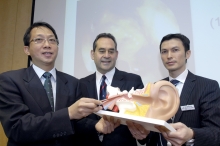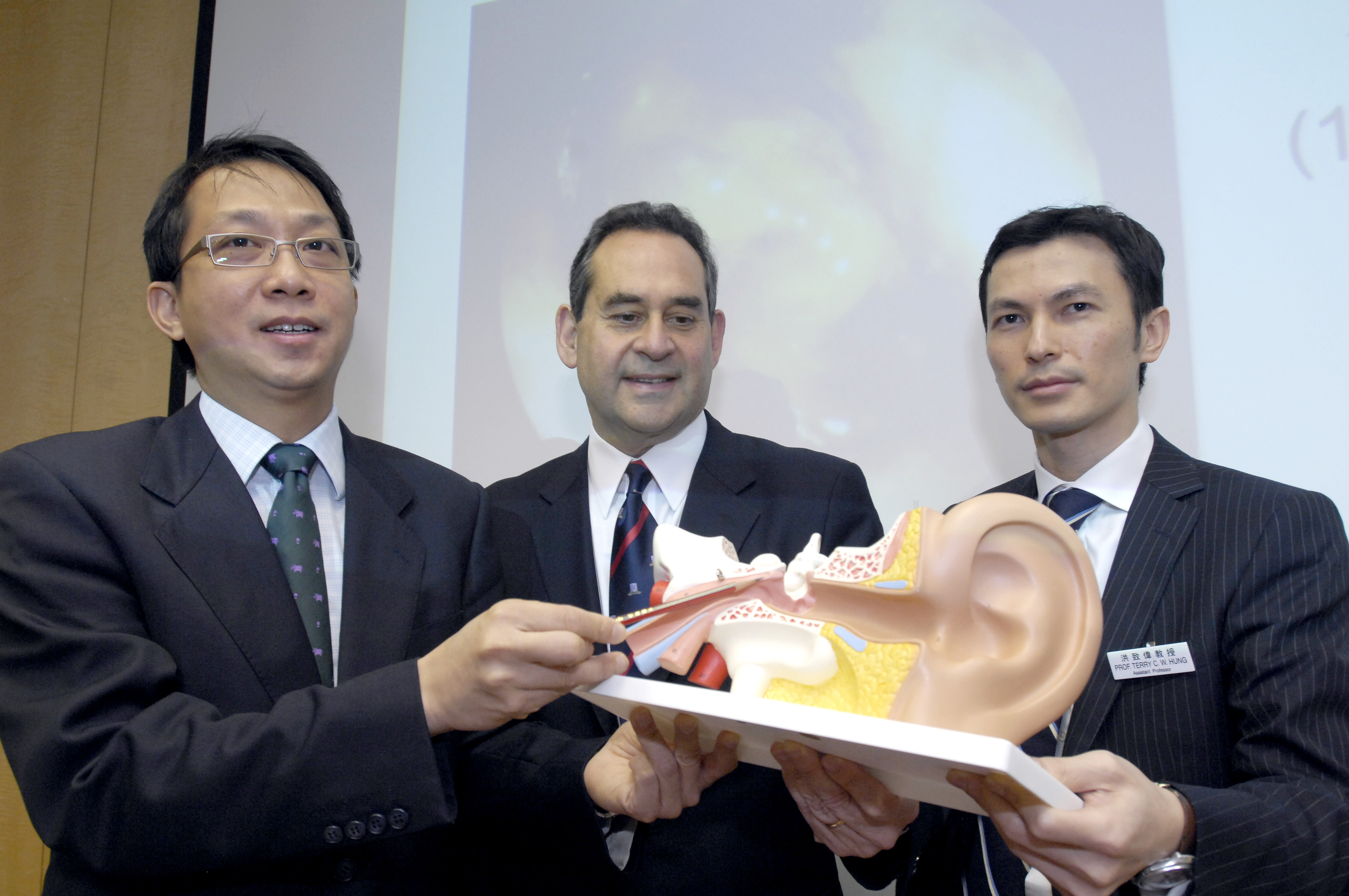News Centre
The Impressive Long Term Results of the Hong Kong Flapsin Treating Discharging Ears
The Hong Kong Flap, an innovative reconstructive technique in ear surgery devised at The Chinese University of Hong Kong (CUHK) was pioneered in the mid-1980s and its use has spread around the world. In Hong Kong alone, it has so far been employed in more than 400 operations on patients with a discharging ear. In the great majority of these patients, the discharge was caused by a cholesteatoma, a common and potentially dangerous chronic middle ear condition. A long term study of these patients just concluded by CUHK shows that the Hong Kong Flap is highly successful in achieving ears that are dry and stable as well as disease free in a single operation.
It is estimated that around the world some ten million people are living with a cholesteatoma. This is typically caused by poor function of the Eustachian tube, which links the pharynx and the middle ear, together with repeated middle ear infection. The skin of the eardrum grows abnormally into the middle ear cleft, typically leading to a malodorous discharge and hearing loss. Especially when the cholesteatoma takes a cyst-like form and increases in size as old skin is shed, the surrounding bone can easily be invaded. The patient is seriously at risk for meningitis and brain abscesses if the disease is left untreated.
The accepted conventional treatment for cholesteatoma has long been mastoidectomy, which surgically removes infected cells from the bone in the skull behind the middle ear. Up to 60 percent of patients, however, may still have a discharging ear long after surgery. This can result from poor mucosal lining or unfavourable structural factors, such as a small ear canal, and there may be a residual or recurrent cholesteatoma in the mastoid cavity. The ultimate solution to such intractable problems proved to be the Hong Kong Flap, a new reconstructive technique pioneered nearly 20 years ago by Professor Andrew van Hasselt, Chairman of the Department of Otorhinolaryngology, Head and Neck Surgery, CUHK and Dr K C Liu, Honorary Clinical Associate Professor of the Department.
Professor Terry Hung, Clinical Assistant Professor at CUHK, reviewed outcomes for 302 patients, aged 4 to 76 years, who had undergone the Hong Kong Flap procedure from 1987 to 2006. Their main symptom was a discharging ear with a cholesteatoma as the major cause. The average follow-up period was 6 years, and 91.3 percent of the patients were rid of their cholesteatoma after one operation, while the remaining patients required simple outpatient management of minor residual disease. The median time from Hong Kong Flap reconstruction to a dry ear was two months. All cases studied eventually achieved dryness of the ear even where the circumstances were unfavourable. The societal impact of this successful operation can be best appreciated when it is noted that the average age of patients at the time of operation was only 40, a prime income earning age.
The Hong Kong Flap uses a deep flap of tissue dissected away from the temporalis fascia, or temple, to completely cover all raw areas within the mastoid cavity left after mastoidectomy. Excellent healing is ensured by the fact that the flap has its own network of blood vessels supplied with blood through the long pedicle which connects it to its site of origin close to the ear. The flap’s living tissue forms the ideal basis for a protective epithelial layer to form.
“The beauty of the Hong Kong Flap technique lies in the essential simplicity of the procedure,” explained Professor van Hasselt. “This is well within the competence of the average ear, nose and throat surgeon. No special equipment is needed, and the reconstruction procedure using the flap adds only a little time to the whole operation.”
“The Hong Kong Flap provides the ideal means of mastoid reconstruction,” noted Dr Liu. “The result is a safe and dry cavity with minimal complications, little chance of recurrence, and a remarkable improvement in the quality of life for patients.”
The CUHK study offers resounding evidence to support the experience of the many surgeons and clinicians around the world who have successfully put the Hong Kong Flap to the test. The poor healing so often associated with mastoidectomy has been overcome, multiple operations and revisions as a result of a mastoidectomy breaking down are increasingly rare, and untold numbers of patients have benefited, returning confidently to normal life and work.

From left: Prof. Michael Tong, Head of Academic Divisions, Department of Otorhinolaryngology, Head and Neck Surgery, CUHK Prof. Andrew Van Hasselt, Chairman, Department of Otorhinolaryngology, Head and Neck Surgery, CUHK Prof. Terry Hung, Assistant Professor, Department of Otorhinolaryngology, Head and Neck Surgery, CUHK
